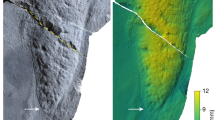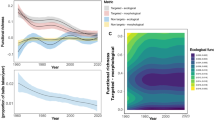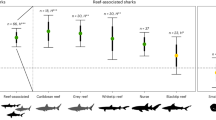Abstract
IN spite of its notoriety, population densities of Acanthaster planci (L.) on most flourishing reefs in the Indo-West Pacific are low. It is possible, however, to find reefs in the region which support aggregations of hundreds or thousands of this starfish1–8. In the Sudanese Red Sea we usually found A. planci densities of 5 to 20 per km of reef face, but on four reefs aggregations of several hundreds within a few hundred metres were studied9. These starfish were not evenly distributed but were usually separated into small subgroups of up to fifteen animals. Such subgroups tended to be associated with favoured species of corals, such as Goniastrea, Turbinaria, Montipora and tabular Acropora spp., whose shapes allowed several individuals to feed together and provided shelter from daylight.
This is a preview of subscription content, access via your institution
Access options
Subscribe to this journal
Receive 51 print issues and online access
$199.00 per year
only $3.90 per issue
Buy this article
- Purchase on Springer Link
- Instant access to full article PDF
Prices may be subject to local taxes which are calculated during checkout
Similar content being viewed by others
References
Vine, P. J., Nature, 228, 341 (1970).
Australian Joint Government Report on Acanthaster planci, Report of the Committee on the Problem of the Crown-of-thorns Starfish (1970).
Ormond, R. F. G., and Campbell, A. C., Symp. zool Soc. Lond., 28, 433 (1971).
Chesher, R. H., Acanthaster planci: Impact on Pacific Coral Reefs (report (abridged) from Westinghouse Research Laboratories to U. S. Department of Interior, 1969).
Dana, T. F., Science, N.Y., 169, 894 (1970).
Weber, J. N., and Woodhead, P. M. J., Mar. Biol., 6 (1), 12 (1970).
Vine, P. J., Atoll Res. Bull. (in the press).
Endean, R., and Chesher, R. H., Biol. Conserv., 5, 2–87 (1973).
New Studies on the Coral Predating Starfish Acanthaster planci, Report of the third Cambridge Red Sea Expedition 1970 (edit. by Roads, C. H., and Ormond, R. F. G.) (1971).
Feder, H. M., and Christensen, A. M., in Physiology of Echinodermata (edit. by Boolootian, R. A.), 87 (Interscience, New York, 1966).
Castilla, J. C., and Crisp, D. J., J. mar. Biol. Ass. U.K., 50, 829 (1970).
MacGinitie, G. E., and MacGinitie, N., Natural History of Marine Animals (McGraw-Hill, New York, 1949).
Hyman, L. H., The Invertebrates, 4 (McGrawHill, New York, 1955).
Reese, E. S., in Physiology of Echinodermata (edit. by Boolootian, R. A.), 157 (Interscience, New York, 1966).
Chesher, R. H., Science, N.Y., 165, 280 (1969).
Owens, D., Fiji Agriculture J., 33, 115 (1971).
Author information
Authors and Affiliations
Rights and permissions
About this article
Cite this article
ORMOND, R., CAMPBELL, A., HEAD, S. et al. Formation and Breakdown of Aggregations of the Crown-of-Thorns Starfish, Acanthaster planci (L.). Nature 246, 167–169 (1973). https://doi.org/10.1038/246167a0
Received:
Revised:
Issue Date:
DOI: https://doi.org/10.1038/246167a0
This article is cited by
-
Predator–prey behavioural interactions between the asterinid seastars Meridiastra calcar and Parvulastra exigua sympatric on the rocky shores of southeast Australia
Marine Biology (2021)
-
DNA-based identification of predators of the corallivorous Crown-of-Thorns Starfish (Acanthaster cf. solaris) from fish faeces and gut contents
Scientific Reports (2020)
-
Crown-of-thorns starfish larvae are vulnerable to predation even in the presence of alternative prey
Coral Reefs (2020)
-
Chemical Ecology of Chemosensation in Asteroidea: Insights Towards Management Strategies of Pest Species
Journal of Chemical Ecology (2018)
-
The role of vision for navigation in the crown-of-thorns seastar, Acanthaster planci
Scientific Reports (2016)
Comments
By submitting a comment you agree to abide by our Terms and Community Guidelines. If you find something abusive or that does not comply with our terms or guidelines please flag it as inappropriate.



